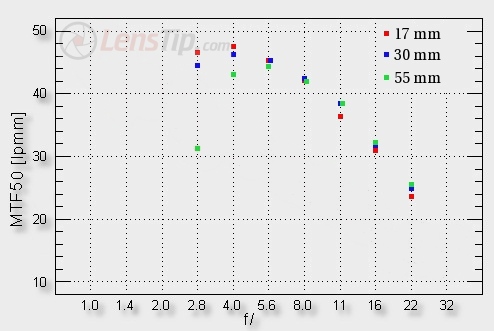Nikon Nikkor AF-S DX 17-55 mm f/2.8G IF-ED
4. Image resolution

The results for 17-30 mm focal lengths please us very much indeed. MTF50 values are worth the best prime lenses and the pictures are of the exquisite quality even with the maximum aperture. Worse results you get with 55 mm focal length, which, especially for f/2.8, stand out from the others. I must add, though, that even there we reach the level above 30 lpmm, which is accepted by us as a useful picture borderline. A slight closure makes all the reservations disappear.
Please Support UsIf you enjoy our reviews and articles, and you want us to continue our work please, support our website by donating through PayPal. The funds are going to be used for paying our editorial team, renting servers, and equipping our testing studio; only that way we will be able to continue providing you interesting content for free. |
- - - - - - - - - - - - - - - - - - - - - - - - - - - - - - - - - - - - - - - - - - - - - - - -
How does it compares with its competitors? Both Canon and Tamron give more even results, with smaller differences between the maximum and the minimum aperture. You might notice that these differences are so slight because of two factors: one positive and one negative. Firstly, maximum focal length and f/2.8 results are a tad better than Nikkor’s, because Canon and Tamron reach 32lpmm, like Nikkor, but only while working with a 8-megapixel matrix of Canon 20D. On the other hand, their maximum achievements, reaching 40-42 lpmm, even if we take into account the difference between the pixels density level, aren’t as high as Nikkor’s, which can reach even 46-47 lpmm.
To sum up: in the frame centre Nikkor 17-55 mm gives us exactly what should be given by a professional lens – a great picture quality in full range of apertures and focal lengths.
Next picture shows us the frame borders.

The lack of failures here is praiseworthy indeed. In the full range of apertures and focal lengths Nikkor has results exceeding 30 lpmm so there are hardly any reservations to be expressed. Only one combination of the focus 55mm and f/2.8 gets the result of 29 lpmm so a bit under 30 lpmm. Taking into account the fact that the measurement errors reach here almost 1 lpmm we can turn a blind eye to this fact with understanding.
When we start comparing with the competitors, Nikkon gets even more praise. Tamron 17-55 clearly loses when it comes to maximum aperture, with the results of 20 lpmm level. Canon 17-55 mm f/2.8 is better than Tamron but still worse than Nikkor – for the maximum aperture it gets not more than 30 lpmm. Its best results for the frame border reach only 33 lpmm whereas Nikkor reaches even 38 lpmm. Again, even if we take into account the difference between the pixels density level of the different matrixes, Nikkor wins.






